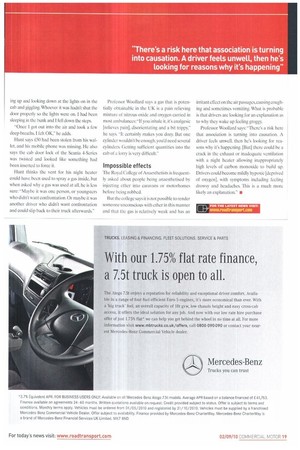the air tonight?
Page 18

Page 19

If you've noticed an error in this article please click here to report it so we can fix it.
Are HGV drivers really being gassed in their cabs, or is there a more prosaic explanation?
Words: Chris Tindatt THE CLAIMS ARE many and stretch back years, hut the evidence proving that gas attacks on sleeping drivers are a disturbing reality remains as elusive as the anaesthetic agent supposedly used.
But the reports of attacks continue to grow in number, although the effects experienced by drivers insisting they arc the victims of gassings remain curiously inconsistent.
One recent incident brought the subject back into the headlines again after driver Bob Ward claimed to have been exposed to a noxious agent while he slept in his cab in Belgium ( CM 12 August). Ward says that at some point between 8pm and 4am, gas was used on him in order that stowaways could board his trailer. He says he woke up feeling light-headed and suffering from a headache and blurred vision. By the time he reached Dover, his legs -were like jelly" and he called for an ambulance.
However, the paramedic's notes reveal that Ward's pulse, blood pressure, respiratory rate, breathing, airways and circulation were all within their normal range.
The paramedic recorded: "Impression: post gassing" on the patient assessment form, although this is not an official diagnosis But Ward insists that he is the victim of a gas attack and that his vision has been affected by CS gas mixed with another agent, adding: "It doesn't matter what you do, if they are going to get in to your trailer, they will get in."
Medical view
But his claim that he was attacked with CS gas in order to anaesthetise him has been disputed by Professor Malcolm Woollard, ex-chair of the College of Paramedics Woollard advises the military on weapons-grade anaesthetic agents and says: "I wouldn't dispute drivers are being attacked, but whatever they are being attacked with, it's not CS gas. It doesn't knock you out, it's a profound irritant. Assuming it would get through the ventilation system, which is fairly unlikely, it precipitates on cold metal surfaces. You would have to be pretty close and fire it
into the face. It's very unlikely that sufficient quantity of vapour would get through to sleeping lorry drivers through vents, and if it did, they would be up like a shot."
It is hardly provocative to point out that individual testimonies don't seem to hold much water and are riddled with holes However, the number of claims is remarkable.
For example, a driver contacted CM stating there had been as many as three gas attacks in one night in Belgium recently, a country regularly quoted as being at the centre of attacks on HCN drivers.
But Belgium is not the only country in which drivers claim this is happening. John Hunt says he was gassed in 2003 in Capellen, Luxembourg, and that he counts himself lucky he didn't suffer any permanent damage.
Hunt says he awoke feeling -giggly, a bit tipsy, butt had had nothing to drink. I remember wak
ing up and looking down at the lights on in the cab and giggling. Whoever it was hadn't shut the door properly so the lights were on. I had been sleeping in the bunk and I fell down the steps "Once I got out into the air and took a few deep breaths. I felt OK," he adds.
Hunt says £50 had been stolen from his wallet, and his mobile phone was missing. He also says the cab door lock of the Scania 4-Series was twisted and looked like something had been inserted to force it.
Hunt thinks the vent for his night heater could have been used to spray a gas inside, but when asked why a gas was used at all. he is less sure: "Maybe it was one person, or youngsters who didn't want confrontation. Or maybe it was another driver who didn't want confrontation and could slip back to their truck afterwards." Professor WooHard says a gas that is potentially obtainable in the UK is a pain relieving mixture of nitrous oxide and oxygen carried in most ambulances: "If you inhale it, it's analgesic [relieves pain], disorientating and a bit trippy," he says. "It certainly makes you dozy. But one cylinder wouldn't be enough, you'd need several cylinders. Getting sufficient quantities into the cab of a lorry is very difficult."
Impossible effects
The Royal College of A rricsthetists is frequently asked about people being anaesthetised by injecting ether into caravans or motorhomes before being robbed.
But the college says it is not possible to render someone unconscious with ether in this manner and that the gas is relatively weak and has an irritant effect on the air passages, causing coughing and sometimes vomiting. What is probable is that drivers are looking for an explanation as to why they wake up feeling groggy.
Professor Woollard says: "There's a risk here that association is turning into causation. A driver feels unwell, then he's looking for reasons why it's happening. [But] there could be a crack in the exhaust or inadequate ventilation with a night heater allowing inappropriately high levels of carbon monoxide to build up. Drivers could become mildly hypoxic [deprived of oxygen], with symptoms including feeling drowsy and headaches 'Ibis is a much more likely an explanation." •
























































































































































































































































